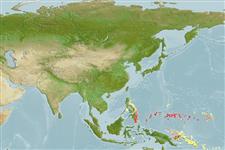Actinopterygii (ray-finned fishes) >
Perciformes (Perch-likes) >
Labridae (Wrasses) > Cheilininae
Etymology: Cirrhilabrus: Latin, cirrus = curl fringe + Greek, labros = furious (Ref. 45335); earlei: Named in honor of John L. Earle who collected the holotype.. More on author: Randall.
Environment / Climate / Range
Ecology
Marine; reef-associated; depth range 60 - 92 m (Ref. 41654). Tropical, preferred ?
Western Central Pacific: Palau.
Size / Weight / Age
Maturity: Lm ? range ? - ? cm
Max length : 6.9 cm SL male/unsexed; (Ref. 41654)
Short description
Morphology | Morphometrics
Dorsal
spines
(total): 11;
Dorsal
soft rays
(total): 9;
Anal
spines: 3;
Anal
soft rays: 9;
Vertebrae: 25. Median predorsal scales 4-5; horizontal rows of scales on cheeks 2; dorsal fin with progressively longer spines; interspinous membranes of dorsal fin of males not extending above spine tips; caudal fin rounded to rhomboid; pelvic fin short, 4.05-4.9 in SL. Color in life pale red, shading to pale yellow on abdomen, with deep red longitudinal lines on body following scale rows; head with two deep pink bands, one from upper lip passing over eye to origin of dorsal fin, the other from lower lip along mandible to corner or preopercle; operculum yellow; dorsal fin yellow anteriorly with a black spot on first membrane, spines red; rest of fin and caudal fin light red with deep red rays; pelvic fins yellow with red spines and rays.
Inhabits mixed coral, rubble, and sand slopes along the bases of steep protected seaward reefs (Ref. 37816).
Life cycle and mating behavior
Maturity | Reproduction | Spawning | Eggs | Fecundity | Larvae
Distinct pairing during breeding (Ref. 205).
Randall, J.E. and R.L. Pyle, 2001. Three new species of labrid fishes of the genus Cirrhilabrus from islands of the tropical Pacific. Aqua J. Ichthyol. Aquat. Biol. 4(3):89-98. (Ref. 41654)
IUCN Red List Status (Ref. 115185)
CITES (Ref. 94142)
Not Evaluated
Threat to humans
Harmless
Human uses
More information
Age/SizeGrowthLength-weightLength-lengthLength-frequenciesMorphometricsMorphologyLarvaeLarval dynamicsRecruitmentAbundance
ReferencesAquacultureAquaculture profileStrainsGeneticsAllele frequenciesHeritabilityDiseasesProcessingMass conversion
Tools
Special reports
Download XML
Internet sources
Estimates of some properties based on models
Phylogenetic diversity index (Ref.
82805): PD
50 = 0.5000 [Uniqueness, from 0.5 = low to 2.0 = high].
Bayesian length-weight: a=0.01660 (0.00723 - 0.03808), b=2.95 (2.76 - 3.14), in cm Total Length, based on LWR estimates for this (Sub)family-body shape (Ref.
93245).
Trophic Level (Ref.
69278): 3.3 ±0.4 se; Based on size and trophs of closest relatives
Resilience (Ref.
69278): High, minimum population doubling time less than 15 months (Preliminary K or Fecundity.).
Vulnerability (Ref.
59153): Low vulnerability (15 of 100) .
